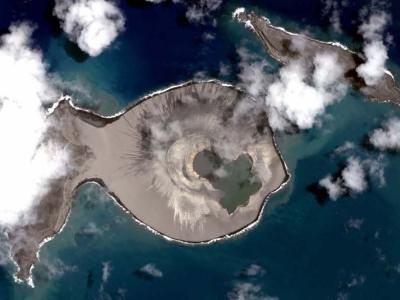Three years ago, the place you see illustrating these lines did not exist. Suddenly, an underwater volcano erupted in the South Pacific and, after the smoke and ashes dispersed, a new mass of earth had appeared: an island that no one had seen before. Thus was born the volcanic island Hunga Tonga, located between two uninhabited Polynesian islands that are part of the Kingdom of Tonga.
In the last 150 years, only three volcanic islands have emerged like this and survived only a few months, the most famous being Surtsey, which appeared off the south coast of Iceland during an eruption that began in 1963.
However, Hunga Tonga is different. It is the only type of island that has emerged in the era of modern satellites, which gives us a new way of studying how these masses of rocky land evolve. In fact, scientists are already using satellite data to learn as much as possible about it, before erosion makes it disappear again under the waters.
"There is a lot of material that came out of this eruption, possibly bigger than in Surtsey," says geologist Vicki Ferrini of Columbia University (USA), who is studying the island with NASA researchers.
At first, the scientists were convinced that Hunga Tonga would last a few months before disappearing, but the island, which covers some 200 hectares and 120 meters over the ocean, could survive even 30 years.
Using real-time satellite data, the team of scientists is developing three-dimensional maps of the topography of the island, studying its changing coasts and the amount of land that lies above sea level.
"Our interest is to calculate how much the three-dimensional landscape changes over time, particularly its volume," says the chief scientist at NASA's Goddard Space Flight Center, Jim Garvin. "It's the first step to understanding erosion rates and processes and to decipher why it persisted longer than most people expected."
These data could inform us about the behavior of volcanic lands that exist much, much further away, as on Mars.
"Everything we learn about what we see on Mars is based on the experience of interpreting the Earth's phenomena," says Garvin. "We believe that there were eruptions on Mars at a time when there were areas of persistent surface water, we could use this new island of Tonga and its evolution as a way to test if any of them represented an oceanic environment or an ephemeral lake."
There's not much time
Nobody knows for sure how long this volcanic island will resist, but we know that it will not live forever, due to the unstable solidified ash cliffs of Hunga Tonga that will erode completely in the coming years.
The findings were presented at the 2017 Fall Meeting of the American Geophysical Union in New Orleans this week.
NOTE: If you do a search for 'Hunga Tonga' in the normal view of Google Maps, you will see an obsolete illustration of two islands separated by an expanse of blue water; but if you move to the satellite view, the newborn island is revealed to us in all its splendor.

Source: Google Maps
Welcome to steemit upvoted :) and keep posting good content, original as much as possible
Downvoting a post can decrease pending rewards and make it less visible. Common reasons:
Submit
Hi! I am a robot. I just upvoted you! I found similar content that readers might be interested in:
http://www.alienture.com/this-island-could-disappear-in-a-few-years/
Downvoting a post can decrease pending rewards and make it less visible. Common reasons:
Submit